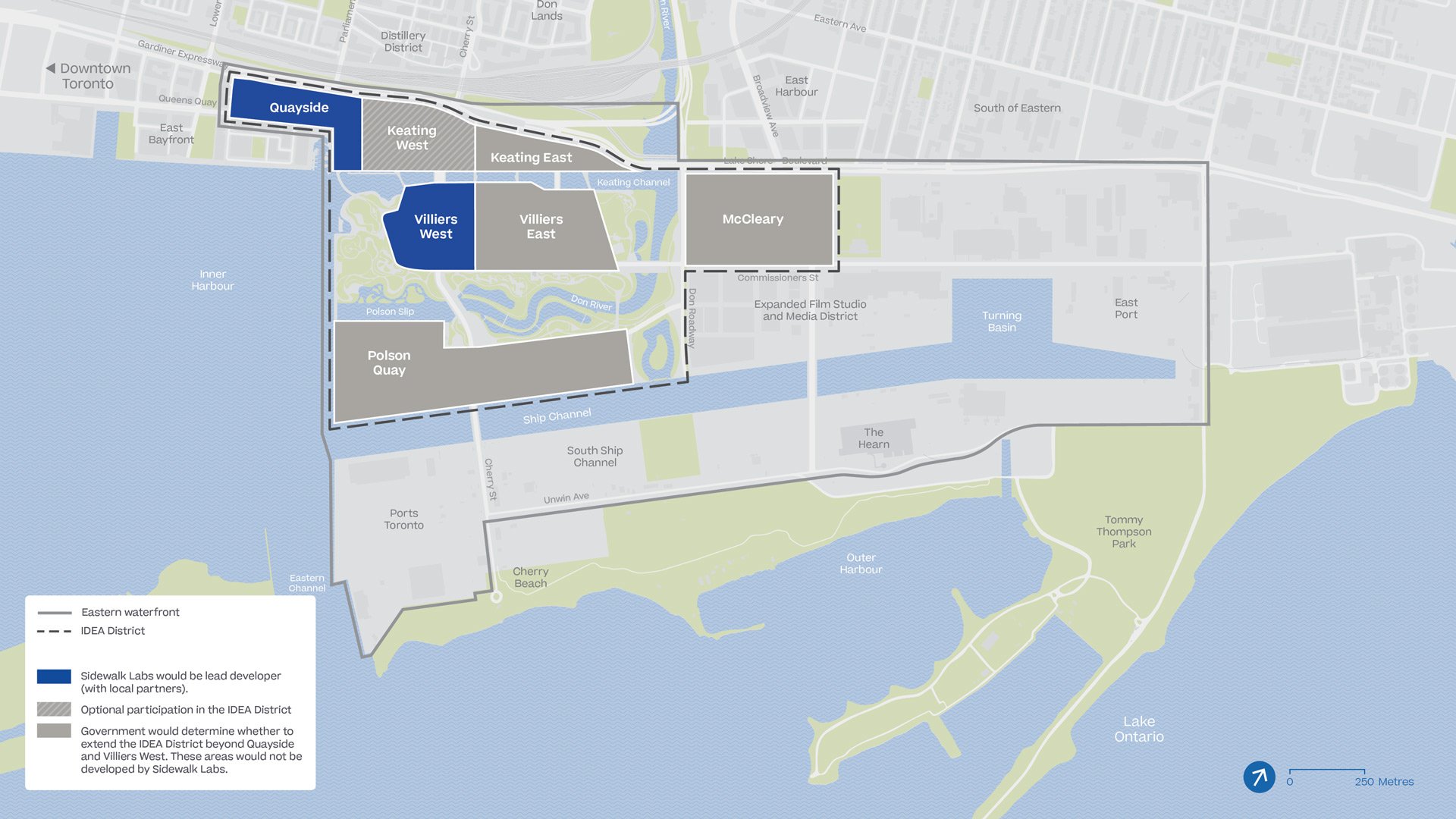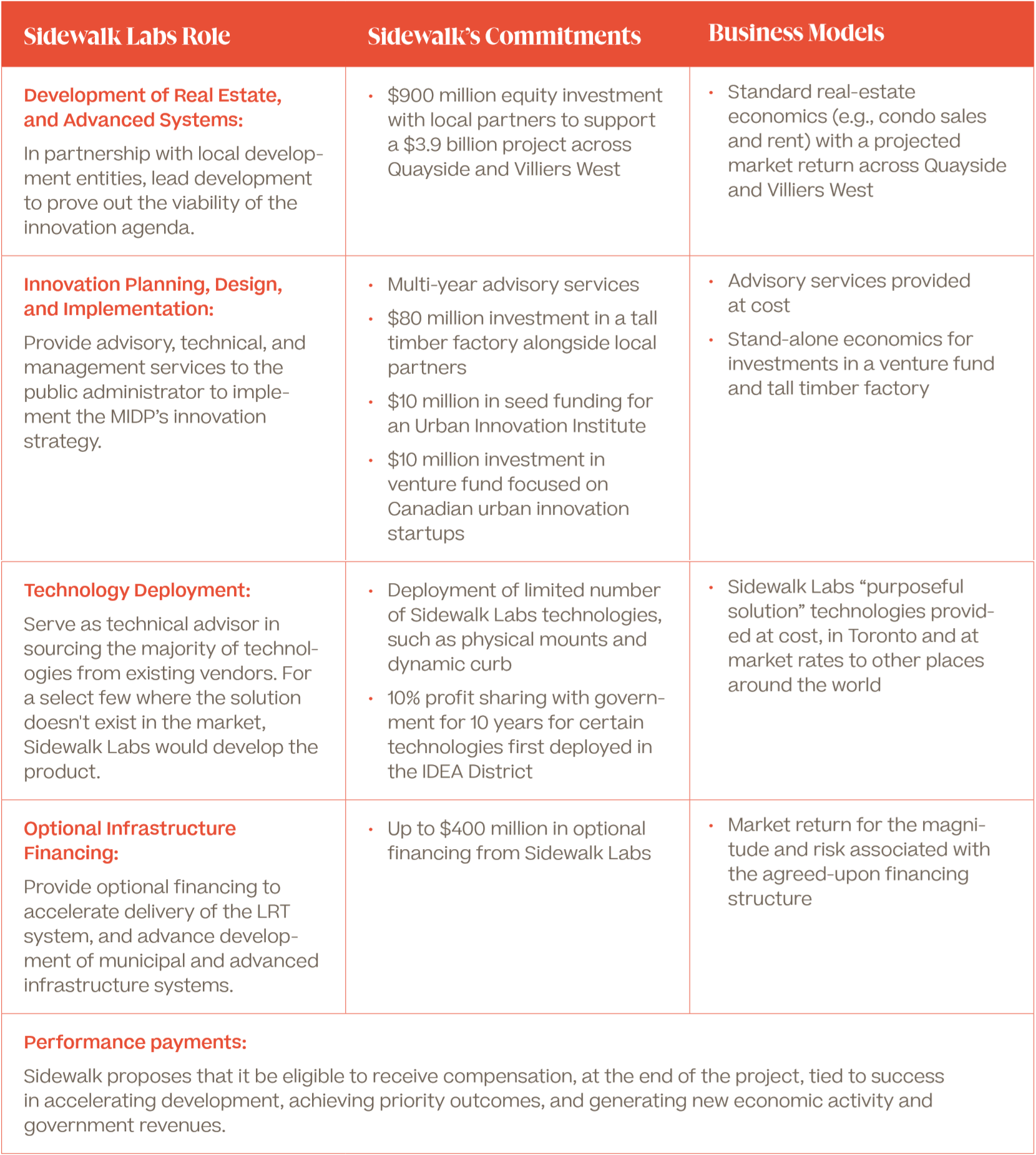testsetset
Alphabet’s Sidewalk Labs today unveiled its draft Master Innovation and Development Plan (MIDP) for Toronto’s eastern waterfront. The 1,524-page plan proposes thermal energy grids, factory-based construction of timber buildings, and a mobility network with heated bike lanes and adaptive traffic signals. You can download the full plan, titled Toronto Tomorrow: A New Approach for Inclusive Growth, from sidewalktoronto.ca.
Google created Sidewalk Labs in June 2015, just a few months before forming its Alphabet parent company. The government-backed agency Waterfront Toronto set aside a 12-acre former industrial area east of downtown on Lake Ontario in March 2017. It initiated a Request for Proposals, which Sidewalk Labs ultimately won in October 2017 (no land was transferred). Sidewalk Labs announced its Toronto project last year. Sidewalk Labs committed more than $50 million over the last 18 months to develop the draft MIDP. The Alphabet company says it has also talked to “more than 21,000 Toronto residents.” Sidewalk Labs has been teasing various smart city technologies for months, but today marks the official unveiling of its overall plan.

Sidewalk Labs would lead real estate development in Quayside and Villiers West, which represent less than 7% of the eastern waterfront. If those are successful, the government could choose to apply them to a broader area, known as the Innovative Development and Economic Acceleration (IDEA) District. Sidewalk Labs is aiming to spend $1.3 billion on the project in the hopes of spurring $38 billion in investments across the IDEA District by 2040. Here is how Sidewalk Labs sees its various potential roles in the years to come:
June 5th: The AI Audit in NYC
Join us next week in NYC to engage with top executive leaders, delving into strategies for auditing AI models to ensure fairness, optimal performance, and ethical compliance across diverse organizations. Secure your attendance for this exclusive invite-only event.

“We realize we have given you an incredible amount of information in the 1,524 pages and by the way several thousands of pages of technical appendices as well that will eventually be available,” Sidewalk Labs CEO Dan Doctoroff told the press today. “But that’s what it takes to do something that is truly different. Now if we do want to solve these enormous urban challenges, it is never going to be doing it the way we’ve done it in the past. And what we think we’re offering here is a way forward for achieving the very elusive broad goal of inclusive growth. And so look forward to the public dialogue going forward and looking forward to interacting with any of you as well as time marches forward.”
The plan includes 10 promises if “approved and implemented at full scale”:
- According to an analysis by urbanMetrics, a third-party economic impact consultancy based in Toronto, the project would generate approximately $4.3 billion in annual municipal, provincial, and federal tax revenues; add $14.2 billion annually to the Canadian gross domestic product (GDP); and create a total of 44,000 permanent jobs (93,000 total direct, indirect, and induced) by 2040.
- Half of all housing units in Sidewalk’s plan would be purpose-built rentals, and 40% of the units would be family-sized (two bedrooms or more). Forty percent of all housing units would be offered at below-market rates, with half of those (20% of all units) meeting traditional definitions of affordable housing and the other half affordable for middle-income households. This plan would generate more than 1,700 below-market units in Quayside and Villiers West.
- Sidewalk’s approach to urban planning would result in 91% more pedestrian open space, while its weather mitigation vision would increase by 35% the number of hours each year it is comfortable to be outdoors. A comprehensive mobility plan incorporates light rail expansion, robust pedestrian and cycling infrastructure, strong accessibility measures, new mobility services, and other innovations, such as heated bike lanes and traffic signals that adapt to real-time use for safety.
- All buildings in Quayside would be built from mass timber, an emerging building material every bit as strong and fire-resistant as concrete and steel, but far more environmentally sustainable and easier to manufacture. Together with local partners, Sidewalk proposes to invest up to $80 million in a mass timber factory in Ontario.
- A thriving ecosystem of tech startups, with a focus on the emerging industry of urban innovation, by providing $10 million in seed funding for a new graduate applied research institute in partnership with local institutions and, together with local partners, $10 million to establish a new venture fund for local, urban innovation-focused startups. Sidewalk’s proposal also includes a commitment by Alphabet to establish a new Canadian headquarters for Google at Villiers West, as part of an agreed-upon transaction within the IDEA District.
- An integrated set of environmental innovations, including sustainable building materials and designs, an advanced power grid for electricity, a clean thermal grid for heating and cooling, a smart disposal chain designed to increase recycling, and active stormwater management. At Quayside, the plan would reduce greenhouse gas emissions by 85%; at the full scale of the IDEA District, emissions would be reduced by 89%.
- An independent, government-sanctioned Urban Data Trust that would oversee all collection and use of data from the physical environment. Separately, Sidewalk Labs has committed to de-identification and Privacy by Design principles, including minimizing data collection; to not selling personal information or using personal information for advertising purposes; and to not sharing personal information with any of its sibling Alphabet companies, including Google, without consent.
- For certain technologies that go on to achieve commercial success elsewhere, Waterfront Toronto and its government shareholders will receive 10% of profits for 10 years.
- A newly naturalized shoreline at Parliament Slip, an entirely new public space nearly the size of Sugar Beach called Parliament Plaza, an expansive greenery and all-ages play space at Silo Park, and dramatically more sidewalk space. All of the spaces would be lively across seasons, supported by technology that makes outdoor spaces accessible year-round, like building “raincoats” that will block rain and wind or provide shade on sidewalks.
- An optional credit enhancement to help enable governments to fund the $1.2 billion, 6.5-kilometre Waterfront East LRT on an expedited timetable without drawing resources away from other transit priorities. Sidewalk’s proposal would be entirely at the government’s option, and in no circumstance would involve private ownership or operation of the LRT.
Again, this is still a plan. Waterfront Toronto will now evaluate Sidewalk’s proposal, along with a public consultation process. A backlash from privacy advocates is inevitable, given Sidewalk Labs’ desire to collect data on citizens, anonymized or not.
